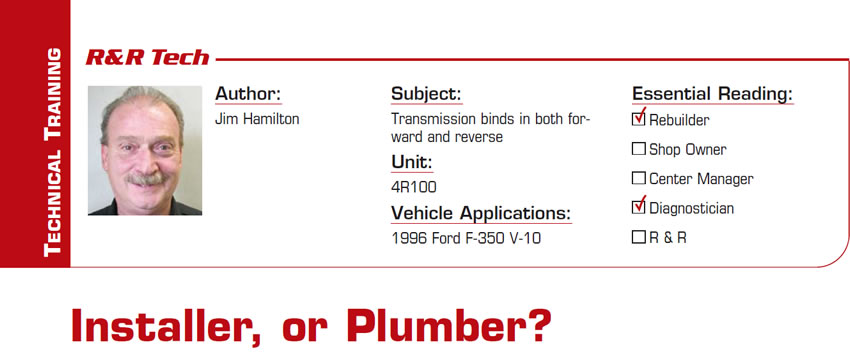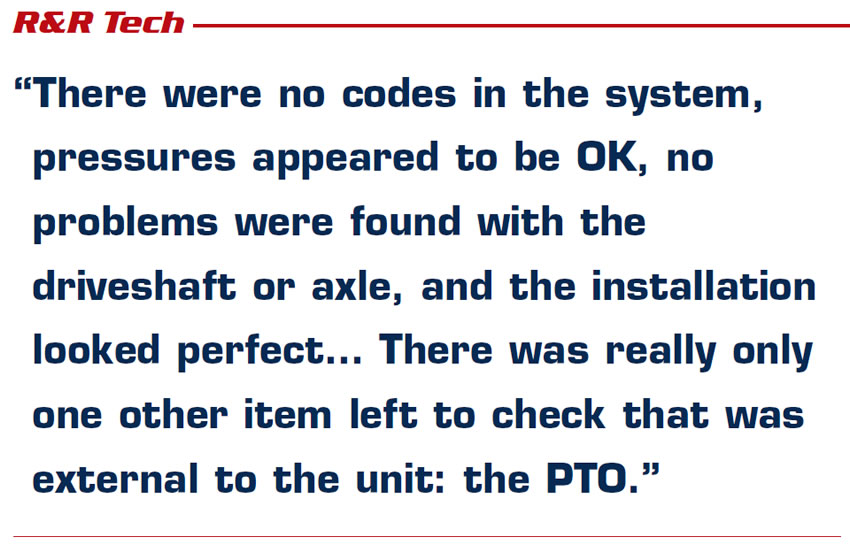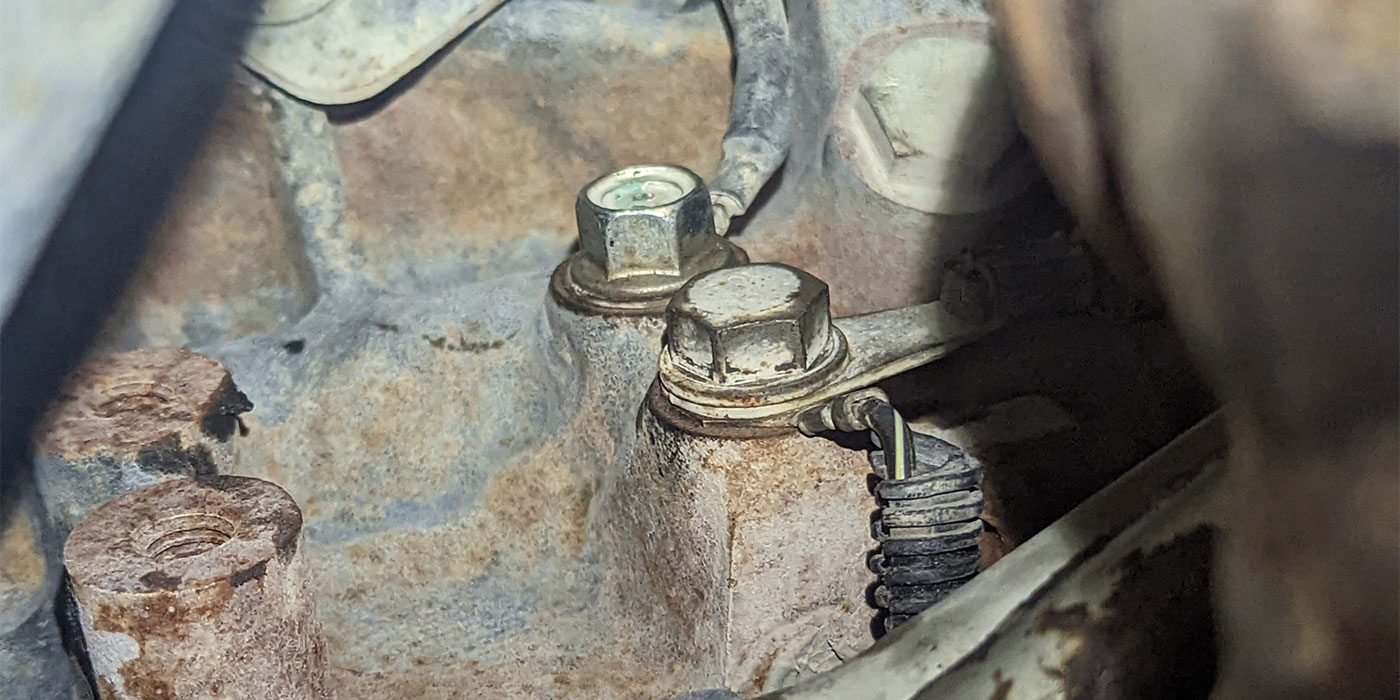
R&R Tech
- Subject: Transmission binds in both forward and reverse
- Unit: 4R100
- Vehicle Application: 1996 Ford F-350 V-10
- Essential Reading: Rebuilder, Diagnostician
- Author: Jim Hamilton
As automotive technicians, there are times when we can forcefully say, “Been there, done that.” As often as those occasions present themselves, so too come the times when we all look at each other, scratching our heads while thinking in unison, “What the …?” This, unfortunately, was one of those times.
It seemed like an ordinary sale. Our customer was a municipal water and gas company that needed a replacement unit for one of its pump trucks. The original transmission for the 1996 Ford F-350 V-10 would not move the vehicle in forward or reverse, and the company had reported that the fluid was black and burnt. We recommended one of our purpose-built heavy-duty units to replace the stock 4R100 for the two-wheel-drive, PTO-equipped application. It seemed like the logical choice, since this vehicle was a short-trip driver that spent a great deal of time remaining stationary while running a water pump through the PTO, not to mention that it was equipped with a large water tank. The company agreed with our recommendation and carried our remanufactured unit out to be installed by its maintenance technicians.
Shortly after the installation, the company called our warranty department to report that the transmission was binding in both forward and reverse. It hadn’t been on the road yet because it would barely back out of the bay. They stated that it would roll only a few feet and the transmission would bind to the point of stopping the truck in both forward and reverse. Since our facility that sold the unit was a full-service shop, it was decided that it would be best for the utility company to bring the truck into our shop to diagnose and repair the problem.
Once we had the vehicle in our possession, we proceeded to verify the complaint. Sure enough, there was a severe bind-up condition in both drive and reverse. Since this was a two-wheel-drive truck and this issue had allegedly presented itself after our transmission was installed, it was easy to assume that our unit was the root cause of the problem. Since it’s our policy to take assumptions out of the diagnostic process, we started digging for answers.

Closer assessment of the problem revealed little additional information. There were no codes in the system, pressures appeared to be OK, no problems were found with the driveshaft or axle, and the installation looked perfect. Canceling the overdrive via the cancel switch seemed to lessen the bind in drive, and the transmission did not bind at all when the truck was rolling in neutral or with the engine shut off. There was really only one other item left to check that was external to the unit: the PTO.
We couldn’t understand how the PTO could even come into play with this issue, but besides replacing the transmission with another unit there was nothing left to check. Since we don’t work with PTO systems regularly, a bit of research was in order so that we could better understand how this system might be playing a part in the issue at hand. We did note that the PTO was unusually noisy when commanded on, but at this point we didn’t know whether this was a preexisting problem or a new issue.
What we did know was that the PTO is powered by a ring gear on the coast-clutch cylinder inside the 4R100 that meshes with the PTO-unit “input” gear. The coast clutch is applied in reverse, first and second gears (provided that the OD-cancel switch has not been activated), manual first, manual second and manual third. Additionally, the coast clutch is also applied when the operator commands the PTO on and the proper conditions are met to allow the PTO to turn on.
Looking for information about the various types of PTO units, we learned that the final output of the PTO generally is controlled by either mechanical engagement via lever, electrical engagement via motor or hydraulic engagement through a clutch internal to the PTO unit. Our vehicle was equipped with the hydraulically engaged output type.
This PTO unit had three hydraulic lines attached to it, all of which fed into a manifold that was fitted with a pressure switch and control solenoid, and an additional line that was attached to the line-pressure port on the transmission case. The line connected to the transmission provides line-pressurized fluid to the manifold and feeds lube oil through a fluid-restrictor port directly to the front of the PTO output gear. This is the “lube” port on the front of the PTO unit.

There are two other ports on the rear of the PTO unit. One of them is the exhaust port in which fluid is “dumped” from the manifold block back into the transmission through the case opening where the PTO unit is bolted to it. The other port is the pressure port, which, when the solenoid is activated, receives pressurized fluid from the manifold to engage the drive clutch on the PTO output.
Nothing appeared to be out of place. On a hunch, our diagnostician decided to cap off the line-pressure feed to the manifold. After he took this pressure away from the PTO system, the truck backed out of the shop with no bind and also moved forward with no issues. Because the lube port also was fed by the pressure line and we had it disconnected, we didn’t road-test the vehicle to prevent damage to the PTO. We determined that we’d found a clue as to why the bind was happening, but now we had to figure out the root of the problem. We took a closer look at the lines themselves.
Since the manifold was easily detached intact from the transmission case, we hypothesized that the installer had not removed the lines when he replaced the unit. It would be simpler to remove the lines from the PTO unit itself, so keeping that logic in mind, we focused our attention there.
The lines themselves are high-pressure rubber hoses and are not formed. We found that they could be routed any number of ways and still appear to be connected where they belonged. By this time we were making the connection that the lines were not in their correct positions. We had three lines that could have been connected in six different combinations, so we had to think about what each line’s job was and how it could affect the operation of the PTO unit.
After we pondered this for a while, the solution presented itself: The PTO clutch was receiving pressurized fluid when it shouldn’t be. As it turned out, the lube and clutch-pressure feed lines had been reversed. The result was continuous pressure to the PTO clutch, but the amount of pressure differed depending on whether the PTO was commanded on. There was less pressure when the PTO was commanded off and more when it was commanded on. That’s why we experienced more noise and increased bind-up when we turned the PTO on.
The bind was being caused by the transmission driving the inadvertently applied PTO clutch, in turn driving the water pump that was connected to the PTO. With a slow roll (as in backing out of the stall), the bind was easily felt because the driving components were trying to overcome the pressure of driving the water pump through the PTO. This also explained why canceling the overdrive electrically lessened this sensation, because doing so had disengaged the coast clutch from its connection to the PTO.
After we corrected the plumbing on the PTO unit, the transmission and PTO worked perfectly. We spared an unnecessary warranty replacement and gained valuable knowledge at the same time.
Through careful reasoning and making no assumptions, we were able to correct the customer’s concern and be the heroes in this complicated tale. The moral of the story is: Consider what you do know, then find answers for all that you don’t know. That’s the way to make the car disappear!

Jim Hamilton has been a diagnostician for Certified Transmission since 1992 and has been involved in the industry for more than 32 years.













